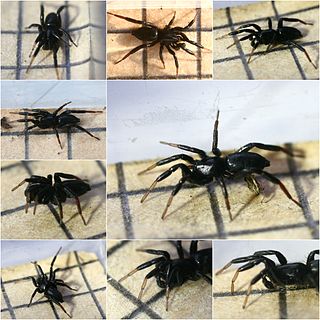
Pimoa is a genus of spiders in the family Pimoidae. Its sister genus is Nanoa.

Psilochorus is a genus of spiders in the family Pholcidae.

Metepeira is a genus of orb-weaver spiders first described by F. O. Pickard-Cambridge in 1903. The name is derived from the Ancient Greek μετά and the obsolete genus name Epeira, denoting a genus similar to Epeira.

Agroeca is a genus of liocranid sac spiders that was first described by Niklas Westring in 1861.

Cicurina, also called the cave meshweaver, is a genus of dwarf sheet spiders that was first described by Anton Menge in 1871. Originally placed with the funnel weavers, it was moved to the Dictynidae in 1967, then to the Hahniidae in 2017. The name is from the Latin root "cucur-", meaning "to tame".

Phrurolithidae is a family of araneomorph spiders, known as guardstone spiders. The family was first described by Nathan Banks in 1892. First included in the Corinnidae as the subfamily Phrurolithinae, later phylogenetic studies justified a separate family.

Micaria is a genus of ground spiders that was first described by Niklas Westring in 1851. They are 1.3 to 6.5 millimetres long.

Hololena is a genus of North American funnel weavers first described by R. V. Chamberlin & Willis J. Gertsch in 1929.

Emblyna is a genus of cribellate araneomorph spiders in the family Dictynidae, and was first described by R. V. Chamberlin in 1948.

Lathys is a genus of cribellate araneomorph spiders in the family Dictynidae, and was first described by Eugène Simon in 1884. It is a replacement name for "Lethia" Menge, 1869 because that name was already in use as a synonym for a genus of moths.

Tricholathys is a genus of cribellate araneomorph spiders in the family Dictynidae, and was first described by R. V. Chamberlin & Wilton Ivie in 1935.

Trachelas is a genus of araneomorph spiders which has variously been placed in families Trachelidae or Corinnidae. Current taxonomy places it in Trachelidae.

Drassyllus is a genus of ground spiders that was first described by R. V. Chamberlin in 1922.
Floricomus is a genus of North American dwarf spiders that was first described by C. R. Crosby & S. C. Bishop in 1925.
Phruronellus is a genus of North American araneomorph spiders first described by R. V. Chamberlin in 1921. Originally placed with the Liocranidae, it was moved to the Corinnidae in 2002, and to the Phrurolithidae in 2014.

Phrurolithus is a genus of araneomorph spiders first described by C. L. Koch in 1839. First placed with the Liocranidae, it was moved to the Corinnidae in 2002, then to the Phrurolithidae in 2014.
Piabuna is a genus of North American araneomorph spiders first described by R. V. Chamberlin & Wilton Ivie in 1933. Originally added to the Liocranidae, it was moved to the Corinnidae in 2002, then to the Phrurolithidae in 2014.
Phonotimpus is a genus of North American araneomorph spiders in the family Phrurolithidae. It was first described by Willis J. Gertsch and Louie Irby Davis in 1940, and placed with the Liocranidae. It was transferred to Corinnidae in 2002, then to the Phrurolithidae in 2014.















